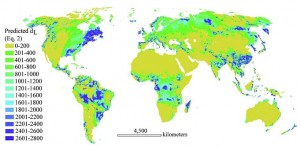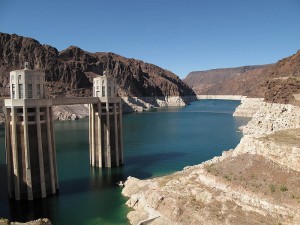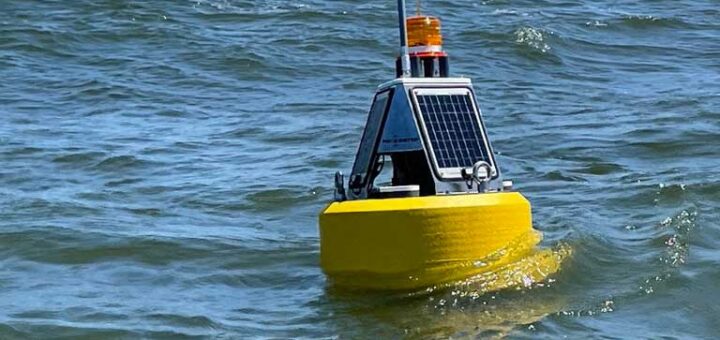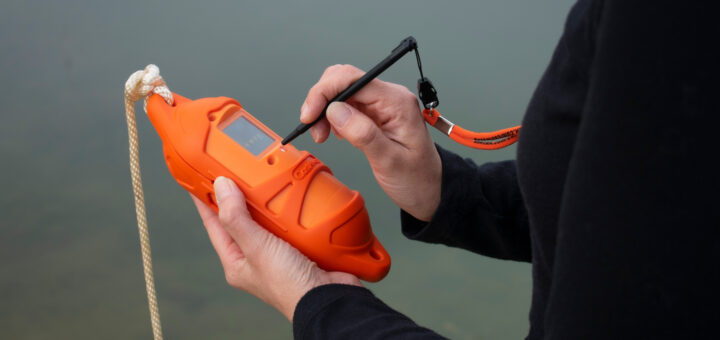Where Are Lakes?
Dave Davis | Kent State University
For many people, lakes are a part of daily life that are taken for granted. They are often viewed as commodities: sources of water for drinking and farming, food, and recreation. Lakes are valued for their aesthetics as well, as shown by the high cost of lakefront properties. While many have gone fishing on a lake in the countryside or hiked out to an alpine lake in the mountains on vacation, it’s important to note lakes aren’t everywhere. In fact, some places don’t have many lakes at all. Where are lakes — and why are they where they are?

A map of the density of lakes (dL) between 1 and 10 km2 around the world shows that lakes tend to occur in specific regions around the world while other regions are largely devoid of lakes. (Image from 1.)
Lakes occupy only a small percentage of Earth’s total surface area. Recent studies estimate the total surface area of lakes at about 4,200,000 km2 — only about 2.8% of the planet’s land surface area (or less than 1% of the Earth’s total surface area)1. It is thought that large lakes such as the Great Lakes of the U.S. and Canada make up a large portion of this total, although small lakes (<0.1 km2) do not commonly appear on maps and may not be counted in typical surveys1. Lakes and other freshwaters range in size from 0.001 km2 for the smallest lakes and ponds, and the largest, the Caspian Sea, at 378,119 km1, 2. Although a few extremely large lakes may dominate area, small lakes dominate the total number of lakes around the world. Lakes of all sizes are an important area of biological study, because while lakes only make a small contribution to the total surface of the planet, they proportionally make a much larger contribution, compared to other environments, to ecological processes such as carbon cycling2 and biodiversity.

Lake Mead’s (Nevada/Arizona) water levels have been dropping in recent decades, revealing a distinctive white “bath tub” ring around its shoreline. For lakes and other water bodies to persist, water losses must be balanced with inputs by precipitation and groundwater.
Based on data collected on lake size distribution, it is estimated there are over 304 million lakes in the world1. Lakes are generally found in specific regions depending on the geology and geography of that area4. Lakes occur in these specific regions typically because of how they form. To support lakes, a region must have depressions in the ground capable of holding water and enough rainfall to sustain the lake’s water supply by balancing evaporation and other losses. The total rainfall in an area correlates strongly to the number of lakes and ponds present; hence, dry areas have fewer lakes1. Additionally, many lakes are manmade (these are also called reservoirs or impoundments). These lakes are typically built for specific purposes, such as water supplies for metropolitan areas or agricultural irrigation and are found near cities or farms. Man-made lakes are quite important both to humans and to other organisms, as their establishment has major effects on aquatic life3.
Using modeling techniques, limnologists have been able to calculate lake distributions for various regions of the world, using lakes of surface area 1-10 km2 as a model1. This data had led to the discovery of some continental trends in lake distribution. In North America, lake distribution tends to be highest in the eastern United States and Canada. Central American countries as well as the northwestern regions of Canada and the United States are also relatively dense with lakes, but the central United States and Mexico have the smallest lake density. South America shows trends of high lake densities in its northeastern and central-eastern regions, but the southern and western regions of the continent have few lakes. Europe shows a fairly uniform distribution, ranging from 601-1000 lakes per 1,000,000 km2, but shows a high density along the northern and southern regions of western Europe. Africa shows few lakes in its northern and southern regions, but possesses a much higher lake density in its central regions. In Asia, much of the lake density is within Russia, southern China, Japan, India, and other surrounding countries. Finally, Australia shows a low distribution of lakes throughout, with the only exceptions being coastal regions of Australia and Papua New Guinea1.
Sources:
- Downing, J. A. et al. 2006. The global abundance and size distribution of lakes, ponds, and impoundments. Limnology and Oceanography, 51(5), 2388-2397.
- Hanson, P.C. et. al. 2007. Small lakes dominate a random sample of regional lake characteristics. Freshwater Biology, 52, 814-822.
- Smith, S.C. et. al. 2002. Distribution and significance of small, artificial water bodies across the United States landscape. The Science of the Total Environment, 299, 21-36.
- Riera, J.L. et. al. 2000. A geomorphic template for the analysis of lake districts applied to the Northern Highland Lake District, Wisconsin, U.S.A. Freshwater Biology, 43, 301-318.









